Click image for BBB rating
See our Privacy Policy
cool="cool" width="787" height="12127" border="0" cellpadding="0" cellspacing="0" gridx="16" showgridx="showgridx" usegridx="usegridx" gridy="16" showgridy="showgridy" usegridy="usegridy" bgcolor="#99ccff">
|
|
|
 |
|
|
|
|
|
|
|
|
Welcome to Spaightwood Galleries, Inc.
120 Main Street, Upton MA 01568-6193
|
|
|
|
|
|
|
In The Apocalypse, The Large Woodcut Passion, The Small Woodcut Passion, and The Life of the Virgin, Durer presented long series of works drawing upon the Bible's stories of Christ's passion, the Apocalypse, and, mixing the Gospel According to St. Luke with legends of the Virgin, the Life of the Virgin. After all of these assumed their final form in 1511, Durer was drawn into the service of the Hapsburg Emperor Maximilian I, who commissioned Durer (along with a number of other important German artists) to produce a large Triumphal Arch out of many joined woodcuts. When he began experimenting with etchings, however, Durer returned to the Passion for the subjects of two of his six etchings. Along with a number of engravings of The Virgin and Child, Durer was also drawn in the wars of the Reformation via a book on the Controversy of the Chalice dedicated to him by Andreas Karlstadt, one of Luther's more vehement supporters. Durer's woodcut Last Supper of 1623 displays the chalice quite prominently on the table; the bread plate, empty, is relegated to the floor in front of the table.
Walter L. Strauss in his catalogue raisonnés, Albrecht Durer Woodcuts and Woodblocks (Abaris Books, 1980) and The Intaglio Prints of Albrecht Dürer: Engravings, Etchings, and Drypoints (NY: Abaris, 1981) provides a summary of comments upon each individual work. Strauss's Commentary volume in the Illustrated Bartsch series updates his commentary here and includes exhaustive lists of works after Dürer's prints. As always, Panofsky's Life and Art of Albrecht Durer (Princeton University Press, 1945, revised editions culminating in the 1971 edition) is crucial for an understanding of the work of this great artist and printmaker.
|
|
|
|
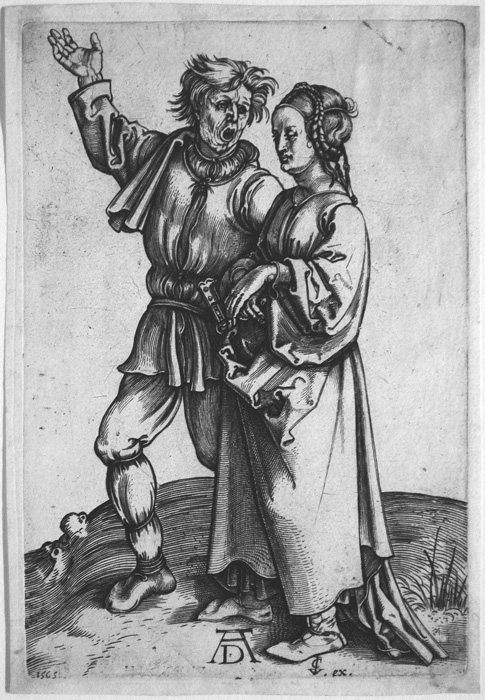 |
|
|
|
Hieronymous (Jerome) Wierix (Antwerp c. 1553-1619), The Peasant and His Wife at Market (Mauquoy-Hendrickx 1705 ii/ii). Engraving after Dürer, 1565. The first state of Wierix's engraving after Dürer's Rustic Couple (Bartsch 83, Meder 86, Strauss 16) was executed in 1565 and originally bore the inscription "IH. W AE 17," a boast that the artist was only 17 when he made this engraving. Our impression is from a later printing in which Wierix's inscription was polished out and Dürer's monogram was added along with CIV[isscher]'s monogram was added as puublisher. Small margins outside the platemark; the lower right corner of the margin shows a small glue stain. Image size: 108x74mm. Price: Please call or email for current pricing information.
This work is reproduced full-size on my 27-inch monitor.
|
|
|
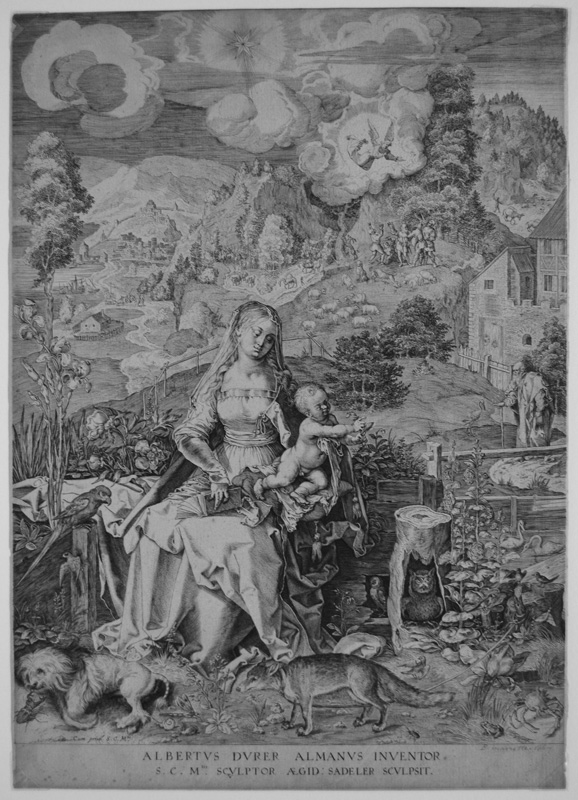 |
|
|
|
|
Aegidius Sadeler (Dutch, c. 1570-1629), Landscape with the Virgin and Child (TIB 7201.072 S2), Etching and engraving after Madonna with a multitude of Animals, a watercolor by Albrecht Dürer listed in The Complete Drawings of Albrecht Durer, vol. 2: 1500-1505, ed. Walter L. Strauss (NY: Abaris Books, 1974), 1503/22, p. 696, . The drawing, formerly the property of the Holy Roman Emperor Rudolf II (who appointed Sadeler Imperial Printmaker) is currently in the Albertina Museum in Vienna, along with many other works formerly belonging to Rudolf II. The infant Jesus holds a bird, a symbol of his Passion to come. St. Joseph can be seen at right with a stork. A very good impression on laid paper with a large watermark: a bunch of grapes within a coat of arms (Briquet 2118 or similar, late 16th c. Germany or Prague). A beautiful piece signed and dated in ink "P. Mariette 1667." Mariette, a famous print dealer and collector, had the habit of signing and sating only the very best impressions he had cquired. Slightly trimmed at top; foxing. Mary and Jesus are surrounded by creatures of land, water, and air; the Annunciation is shown top right. Image size: 338x242mm. Price: SOLD.
|
|
|
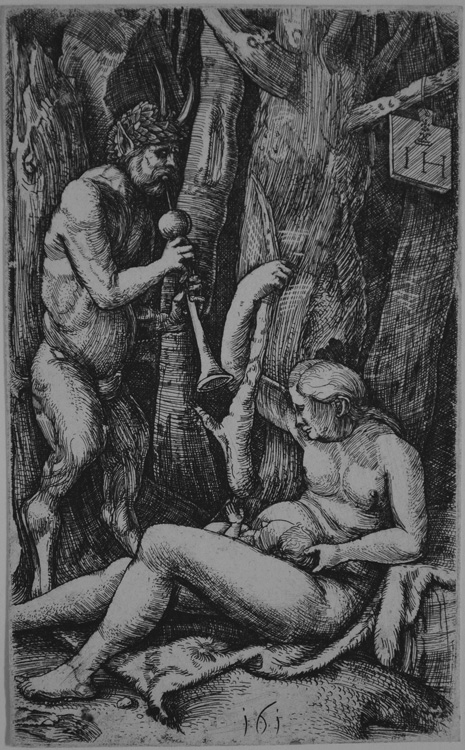 |
|
|
|
Hieronymous (Jerome) Hopfer (German, fl. 1510-1530), The Satyr and his Family (B. 33 ii/ii). Etching after Durer's 1505 engraving of the same title (B. 91, S. 43). Heller notes copies by Hieronymous Hopfer, Wierix, and 4 others, attesting to the popularity of this image. The Hopfer brothers were pioneers in the technique of etching and Dürer apparently learned the technique from them, though he only made 6 etchings himself. Ours is a good impression on laid paper inscribed in the plate with Hopfer's IH monogram hanging from the tree upper right. Ours is a 17th-century impression with the Funck number 161 bottom center-right. Image size: 139x86mm. Price: Please call or email for current pricing information.
|
|
|
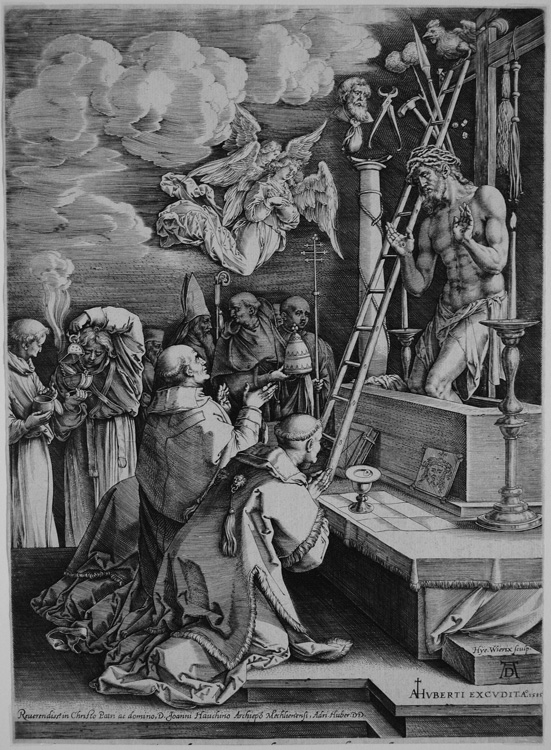 |
|
|
|
Hieronymous (Jerome) Wierix (Antwerp c. 1553-1619), The Mass of St. Gregory (Mauquoy-Hendrickx 1155 i/ii). Engraving after Dürer's 1511 woodcut of the same subject (Bartsch 123, Strauss 160, Meder 226). Signed "Hye Wierix sculp" on top of the stone block lower right and with Dürer's monogram on the face of the block. Inscribed "AHUBERTI EXCVDIT A[nno] 1585" and dedicated to the memory of Joanini Hauchino, Archbishop of Mechlienen, and suggesting that Dürer's works were still the standard of quality. Trimmed inside the platemark but outside the borders of the print on the top and the sides; some text is barely visible below the bottom edge of the print. A beautiful crisp impression in overall quite good condition. Image size: 295x216mm. Price: Please call or email for current pricing information.
This seems to have been a relatively popular work. In addition to Wierix, it also inspired copies by Marcantonio Raimondi, Lambert Hopfer, and 2 other anonymous artists.
|
|
|
|
|
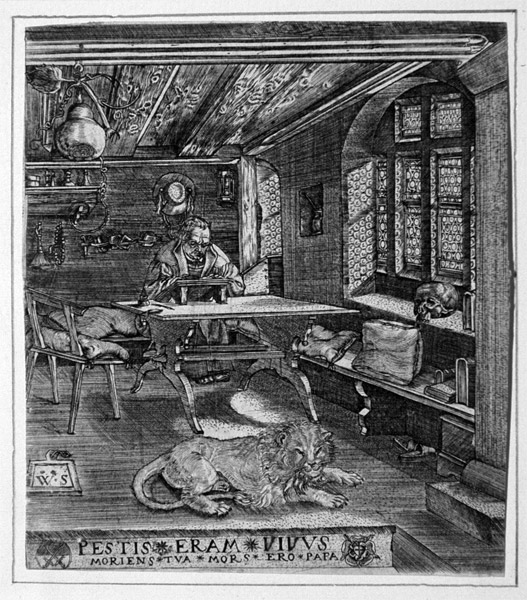 |
|
|
|
|
|
One of Dürer's supreme masterpieces is his 1514 engraving of St. Jerome in his study (Bartsch 60, Strauss 77, Meder 59). Original engraving, 1514. We, alas, have no impression of this wonderful piece, which Vasari describes as part of his discussion of Dürer's prints in his chapter on Marcantonio Raimondi in the second edition of The Lives of the Painters, Sculptors and Architects (1568): "And finally he published St. Jerome in a Cardinal's garb, writing with a sleeping lion at his feet. Dürer depicts a room with glass windows through which the sun is shining and reflected in so natural a manner that one is utterly astonished. Furthermore there are books, an hourglass, writings, and many other things which could be neither rendered in in greater abundance nor more skillfully" (p. 212). Image size: 247x188mm. When Luther died, an engraving, reversed and smaller in size, was published by an artist who signed himself W.S., who has sometimes been identified with Wolfgang Stuben, a German artist active c. 1580--1588. In the first state of the print, the word VIVVS was misspelled FIFVS, in the second state, it was corrected to VIVVS. Our impression is from the first printing. On their website, the British Museum suggests that the print may have been published in 1546, the year in which Luther died, to mark this new stage in his war against Roman Catholicism. The inscription reads, "O pope, while I was alive I was a pest to you; once I am dead I shall be your death." An image of the second state of the engraving is published in Christiane Andersson and Charles Talbot, From A Mighty Fortress: Prints, Drawings, and Books in the Age of Luther 1483-1586 (Detroit: Detroit Institute of Arts, 1983), p. 34. In Dürer's engraving, there is a small crucifix on the right hand corner of the desk, the windows are on the left side of the print, and there is a sleeping dog lying on the floor next to the sleeping lion. The substitution of Luther for St. Jerome is appropriate: St. Jerome gave us the translation of the Old and New Testaments that was accepted in the Catholic Church through the 16th century; Luther's German translation (in itself a forbidden act) immediately became the standard bible in the German-speaking parts of the world and Luther is often credited as the father of German literature. The works of Monogrammist W.S. will be catalogued in The Illustrated Bartsch vol. 22. Image size: 142x128mm. Price: Please call or email for current pricing information.
|
|
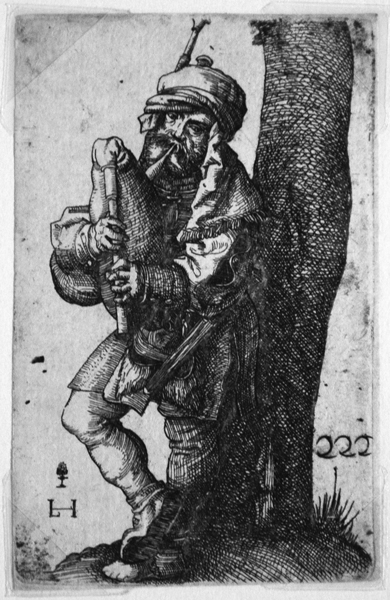 |
|
|
|
Lambert Hopfer (Augsburg, fl. 1520-1530), The Bagpaper (B. 24ii/ii). Etching after Durer's engraving of the same title (B. 91, S. 76). Heller notes copies by Lambert Hopfer, Wierix, and 14 others, attesting to the popularity of this image. The Hopfer brothers were pioneers in the technique of etching and Dürer apparently learned the technique from them, though he only made 6 etchings himself. Ours is a good impression on laid paper inscribed in the plate with Hopfer's intertwined LH monogram. Ours is a 17th-century impression with the Funck number 222 lower right. Image size: 78x50mm. Price: Please call or email for current pricing information.
|
|
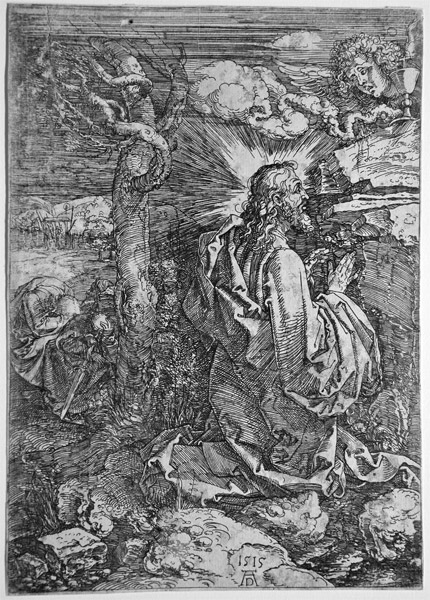 |
|
|
|
Christ's Agony in the Garden of Gethsemene (Bartsch 19, Strauss 82, Meder 19 I b-c). Original etching on iron, 1515. A very good Meder I bc impression, formerly in the Gray Collection of Harvard University and the Fogg Art Museum. Durer made his etchings on iron which quickly rusted and stained the paper when the plate was printed. Ours is an impression before the rust. Repaired tear, upper left corner, extending into image. One of Durer's 6 etchings. Winkler calls this "the first successful etching in respect to the pictorial setting. Signed and dated in the plate. One of Durer's most important prints in an early state. Image size: 221x156mm. Price: SOLD.
|
|
|
|
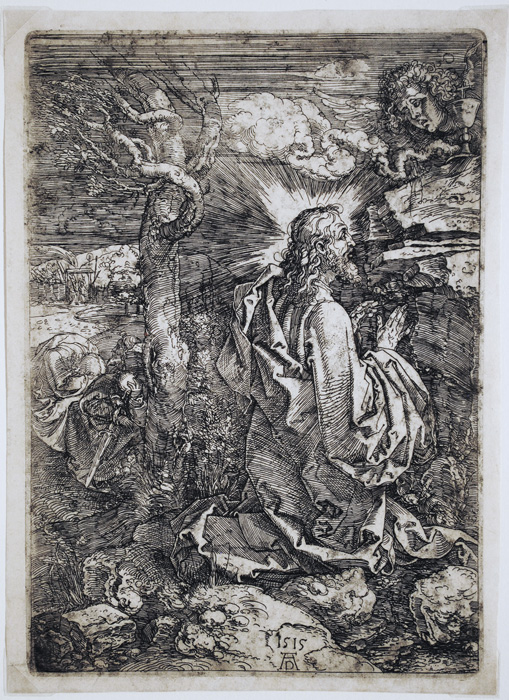 |
|
Christ's Agony in the Garden of Gethsemene (Bartsch 19, Strauss 82, Meder 19 I c). Original etching on iron, 1515. A good Meder IId impression with somewhat unobtrusive rust spots visible across the top and along the sides, where the plate was handled; happily, Jesus, the light emanating from him, and the angel's face, are clear. Overall, the image above is cleaner, but this one is still quite contrasty and strong where Durer wanted it to be strong and contrasty. Jesus prays in the Garden of Gethsemene after the Last Supper that "this cup" (of his crucifixion) might pass, but in response, an angel appears holding the cup and Jesus accepts God's will ("Thy will be done"). One of Durer's 6 etchings. Winkler calls this "the first successful etching in respect to the pictorial setting." Small horizontal ink line in the lower left margin just extending to the platemark (this is not a tear). Printed on a sheet of wove paper, probably at the Reichsdruckerei in the 19th century. Signed and dated in the plate, bottom right-center. One of Durer's most important prints in a late but strong impression. Image size: 223x157mm. Price: Please call or email for current pricing information.
|
|
|
|
|
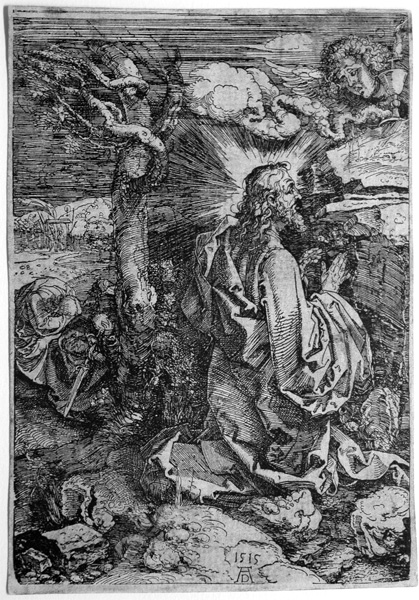 |
|
Christ's Agony in the Garden of Gethsemene (Bartsch 19, reduced-size copy). Engraving after Durer's etching. An excellent 16th-century impression on laid paper of one of Durer's most powerful prints. Image size: 202x142mm. Price: SOLD.
|
|
|
|
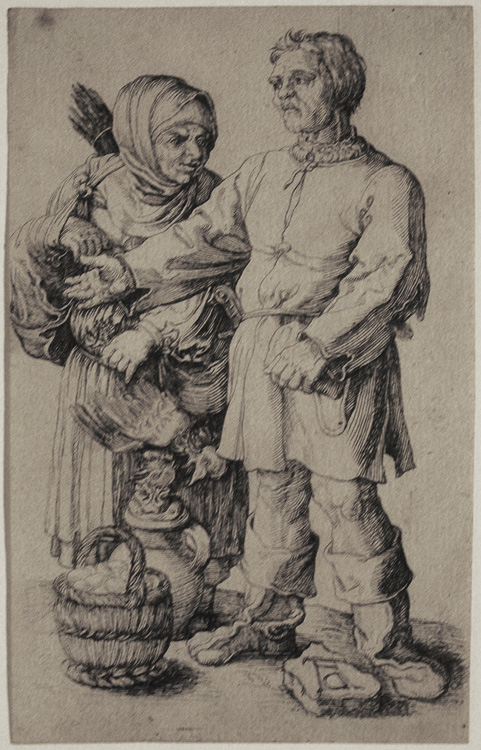 |
|
|
|
|
The Peasant and His Wife at Market (Bartsch 89, Strauss 90, Meder 89). Engraving after Dürer's 1520 engraving. There are over 17 different copies of Dürer's engraving listed in the Commentary volume in the The Illustrated Bartsch series; ours is number 18! It is a same direction copy on laid paper with the D in Dürer's monogram reversed. It is also slightly larger than the original, which measures 116x73mm; ours, cut within the platemark, is 123x77mm. Price: Please call or email for current pricing information.
On our 27 inch monitor, this is slightly larger than in real life.
|
|
|
|
|
|
|
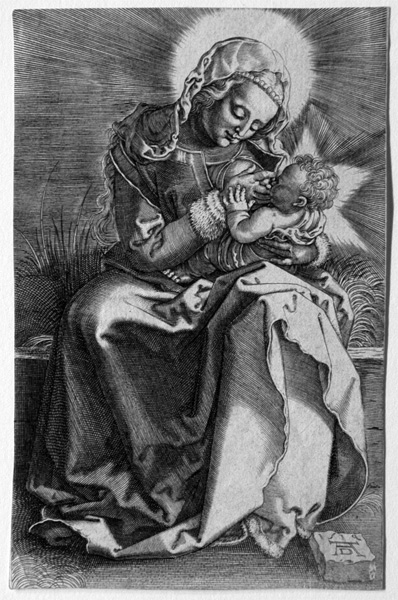 |
|
|
Madonna Nursing (Bartsch 36 copy 4, Strauss 91-reversed). Reverse copy of Durer's c. 1518 engraving. A very good 16th-century impression on laid paper of this work which is based upon one of Durer's late masterpieces. Heller notes that the work was copied by Wierix and 6 other engravers. Trimmed within the platemark. The engraver's initals MD are printed on the right corner of the stone with Durer's monogram. size: 113x72mm. Price: Please call or email for current pricing information.
|
|
|
|
|
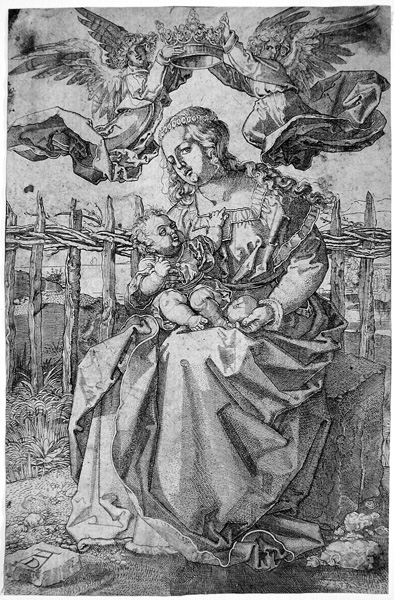 |
|
Madonna Crowned by Two Angels (Bartsch 39, Strauss 87, Meder 19). Reverse copy of Durer's c. 1518 engraving. Good impression trimmed inside the platemark. From the existence of copies by Jacob Binck (c. 1500-1569), Jan Wierix, and 13 others, we may assume that this was one of Durer's most popular prints. Durer's original has been praised as "the prettiest and most elegant of Durer's Madonnas" (Kohler) and as having "a Raphaelesque equilibrium of loveliness & serenity" (Panofsky). Image size: 141x90mm. Price: Please call or email for current pricing information.
|
|
|
|
|
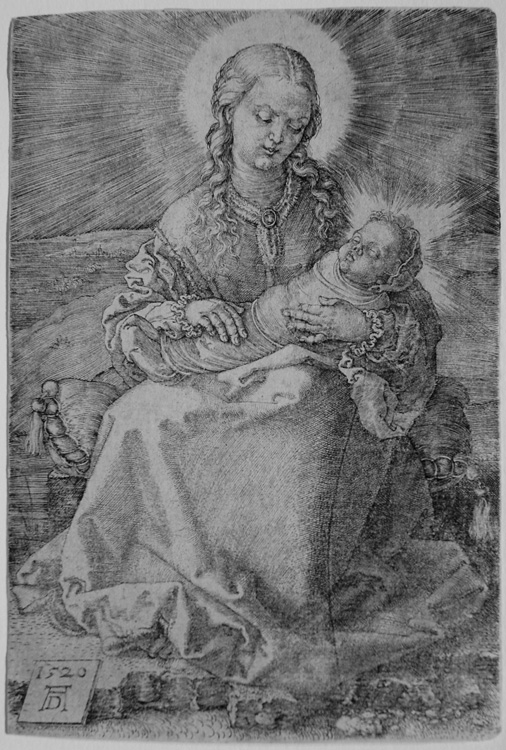 |
|
Madonna with the Swaddled Infant (Bartsch 38, Strauss 94, Meder 40). Original engraving, 1520. A later impression of one of Dürer's most beautiful engravings. Meder says that early impressions are brownish; ours is gray, but still sharp. Ex collection Julian Manheimer (Lugt supp. 1840d, verso). Talbot notes, "There is a strange intensity to Durer's late Madonnas which makes them deeply moving but devoid of all charm" and adds "This rendition is colossal. There is barely enough room for the Madonna's halo to fit within the picture space. The term "sculptural," when applied to this print is less of a metaphor than it was previously. There is a perceptible "stoniness" to this print, as Panofsky observes, to the figure group amd an abstract geometrical rigidity to the drapery folds. The modelling, though handled with supreme virtuosity, lacks all decorative effect . . . one no longer experiences a sense of delight in following the schemes of hatchings aaround the contours of the figures." Talbot goes on to cite Panofsky's argument that this is a consequence to Dürer's conversion to the Lutheran faith with its emphasis on "the Apostles, the Evangelists, and the Passion of Christ" with the result of a stylistic change to a "forbidding, yet strangely impassioned austerity"; see Charles W. Talbot, ed. Durer in America: His Graphic Work (National Gallery of Art, 1971), p. 154. Image size: 143x96mm. Price: Please call or email for current pricing information.
|
|
|
|
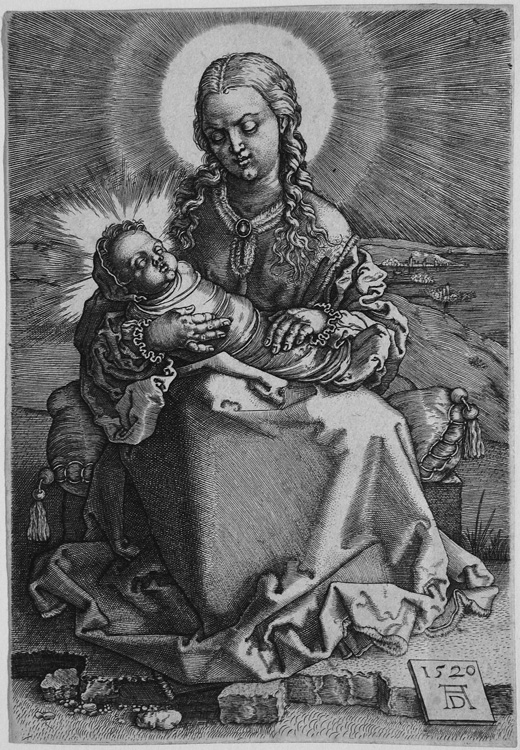 |
|
Madonna with the Swaddled Infant (Bartsch 38, Strauss 94, Meder 40). Reverse copy of Durer's 1520 engraving executed by Jan Wierix (Antwerp, 1549-1618) c. 1563 (Maquoy-Hendrixx 1705). Heller notes the existence of twelve other copies. A beautiful impression on laid paper of one of Wierix' most successful recreations of a Durer masterpiece. The Wierix brothers were among the most proficient engravers in Antwerp in the later 16th century. They chose to make engravings after Durer's masterpieces to prove their technical skills. Image size: 143x100mm. Price: Please call or email for current pricing information.
|
|
|
|
|
|
|
|
|
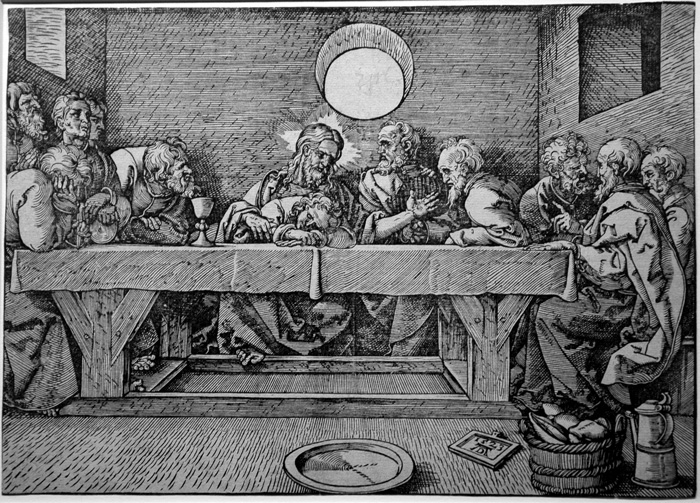 |
|
|
The Last Supper (Bartsch 13 copy 1, Strauss 199, Meder 184). Woodcut after Durer, 1523. This horizontal version of The Last Supper differs radically from Dürer's earlier vertical versions. A very deceptive copy (we purchased it as the original!) on laid paper in very good condition. Unlike the original (see below), the edge of the plate touches the bottom border line. Image size: 209x290mm. Price: Please call or email for current pricing information.
|
|
|
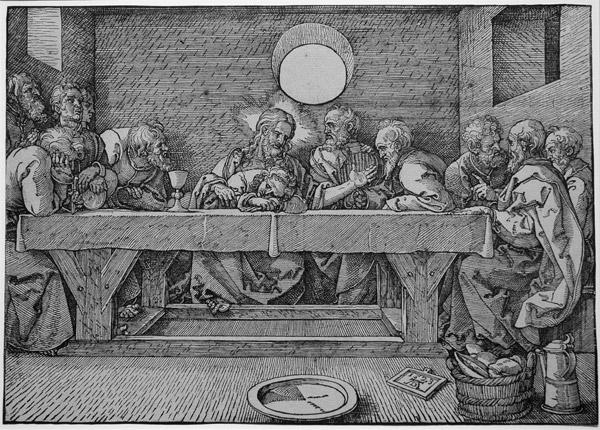 |
|
|
The Last Supper (Bartsch 13, Strauss 199, Meder 184a). Original woodcut, 1523. One of Dürer's last major prints, this version of the Last Supper differs radically from earlier versions. This print is illustrated in almost every study of Dürer's art. An excellent impression of a beautiful print. Image size: 209x290mm. Price: SOLD.
|
|
|
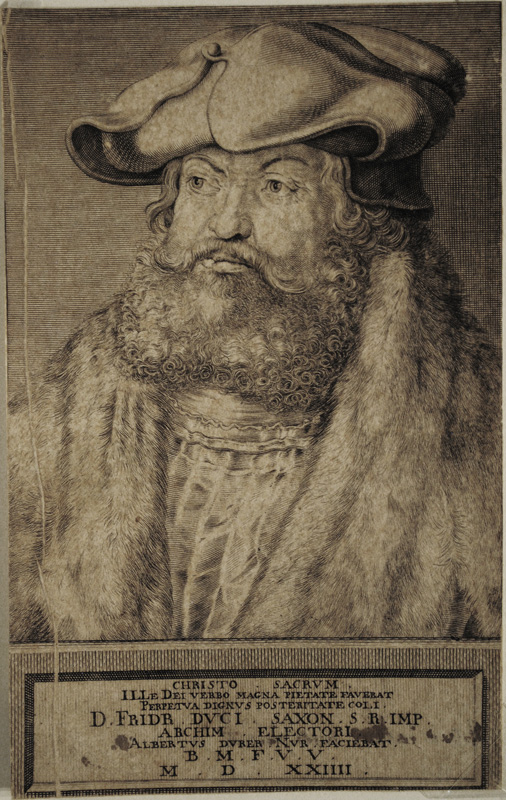 |
|
|
|
Christian Fritsch (Saxony 1695-1769 Hamburg), Frederick The Wise, Elector of Saxony (Bartsch 104, Strauss 101, Meder 102). Engraving after Dürer's 1524 engraving. There are 7 different copies of Dürer's engraving listed in the Commentary volume in The Illustrated Bartsch series of which ours is number 2 (lacking the artist's inscription as does the one illustrated in Bartsch. Acccording to the inscription below the image, Frederick is "Sacred to Christ. He favored the word of God with great piety, worthy to be revered by posterity forever. Albrecht Dürer made this for Duke Frederick of Saxony, Arch-Marshall, Elector of the Holy Roman Empire; B[ene] M[erenti] F[ecit] V[ivus] V[ivo] MDXXIIII." Duke Frederick hid Luther, disguised as Junker Jörg after Luther was condemned at the Diet of Worms in 1520 and protected Luther while he translated the Bible into German, thus enabling the Reformation. Dürer's engraving (which measured 188x122mm) is based on a drawing Dürer made of the Duke when he visited Nuremberg between November 1522 and February 1523. Printed on paper with a vetical welt on the left side; laid down on mat paper. Image size: 150x94mm. Price: Please call or email for current pricing information.
On our 27 inch monitor, this is slightly larger than in real life.
|
|
|
|
|
|
|
|
|
Spaightwood Galleries, Inc.
To purchase, call us at 1-800-809-3343 (1-508-529-2511 in Upton MA & vicinity) or send an email to spaightwood@gmail.com.
We accept AmericanExpress, DiscoverCard, MasterCard, and Visa.
We also accept wire transfers and paypal.
For directions and visiting information, please call. We are, of course, always available over the web and by telephone (see above for contact information). Click the following for links to past shows and artists. For a visual tour of the gallery, please click here. For information about Andy Weiner and Sonja Hansard-Weiner, please click here. For a list of special offers currently available, see Specials.
All works are sold with an unconditional guarantee of authenticity (as described in our website listing).
Go back to the top of this page.
Visiting hours: Saturday 10:00 am to 5:00 pm and Sunday noon to 6:00 pm and other times by arrangement.
Please call to confirm your visit. Browsers and guests are welcome.
|
|
|
|
|
|
|
|
|
|
|
|
|
|
|
|
|
|
|
|
|
|
|
|
|
|
|
|
|
|
|
|
|
|
|
|
|
|
|
|
|
|
|
|
|
|
|
|
|
|
|
















